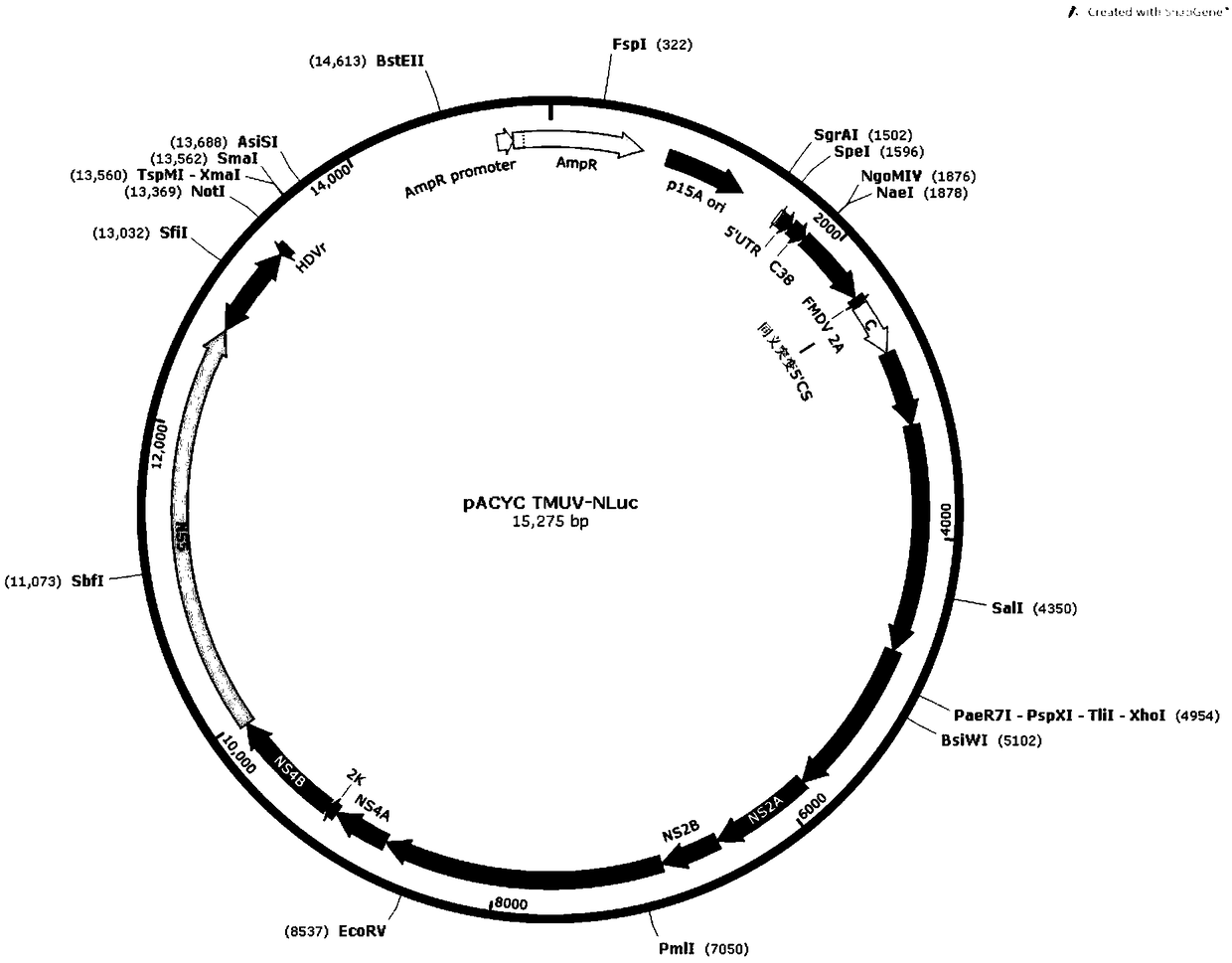Preparation method of reporter duck tembusu virus and product and application thereof
A duck Tembusu virus and reporter virus technology, applied in biochemical equipment and methods, viruses, virus/bacteriophage, etc., can solve the problems of reporter virus instability, long report virus cycle, unfavorable research development, etc., to achieve convenient quantification Detection, excellent sensitivity, and stable performance in passage
- Summary
- Abstract
- Description
- Claims
- Application Information
AI Technical Summary
Problems solved by technology
Method used
Image
Examples
Embodiment 1
[0036] 1. Transformation of the 1-2646 nucleic acid fragment of the duck Tembusu virus genome
[0037] Using pACYC FL-TMUV plasmid as template, using SpeI-F and C38-NLuc-R as primers, fragment A was amplified by PCR; using pJET-NanoLuc plasmid as template, using NLuc-F and NLuc-R as primers, PCR amplified Fragment B was obtained by amplification; fragment C was obtained by PCR amplification with pACYCTMUV-RLuc plasmid as template and FMDV 2A-F and XhoI-R as primers.
[0038] Using SpeI-F and NLuc-R as primers, and fragment A and fragment B as templates, fusion PCR amplification was performed to obtain fragment AB; then SpeI-F and XhoI-R were used as primers, fragment AB and fragment C were used as templates, A second round of fusion PCR amplification was performed to obtain fragment ABC.
[0039] The reaction system of PCR is:
[0040]
[0041]
[0042] The conditions of PCR amplification were: pre-denaturation at 98°C for 1 min; denaturation at 98°C for 10 s, annealin...
Embodiment 2
[0048] 1. In vitro transcription and rescue of reporter virus
[0049] (1) Pick a single colony of the reporter virus plasmid with correct sequencing, shake at room temperature (25°C) at 120rpm / min until the turbidity is appropriate. Use the endotoxin-free plasmid extraction kit to extract the plasmid for later use. Using mMESSAGE mMACHINE TM The T7Transcription Kit was used for in vitro transcription, operated strictly in accordance with the supplier's recommended procedures, and used RNase-free pipette tips and EP tubes.
[0050] (2) In order to prevent the transcription of an overly long chain, 10 μg of the pACYC TMUV-NLuc plasmid was fully linearized with SmaI single enzyme digestion to terminate the transcription;
[0051] (3) Preparation of in vitro transcription system:
[0052] RNase-free ddH2O
Up to 20μl
2xNTP / CAP
10μl
10xReaction buffer
2μl
GTP
1μl
Linearized pACYC TMUV-NLuc
5μl
Enzyme Mix
2μl ...
Embodiment 3
[0065] Assessing passage stability of reporter virus TMUV-NLuc
[0066] The F0-generation reporter virus obtained in Example 2 was continuously passaged in BHK21 cells for 5 times, and the five-generation passaged viruses of F1, F2, F3, F4, and F5 were successively obtained, and each generation of viral RNA was extracted for RT-PCR, and the PCR results were subjected to electrophoresis , to detect whether the reporter gene still exists with the viral genome and whether it is lost. For electrophoresis results, see Figure 6 . The results showed that the reporter gene was not lost at least within 5 generations, indicating that the stability of TMUV-NLuc was significantly better than that of the previously reported duck Tembusu reporter virus.
PUM
 Login to View More
Login to View More Abstract
Description
Claims
Application Information
 Login to View More
Login to View More - R&D
- Intellectual Property
- Life Sciences
- Materials
- Tech Scout
- Unparalleled Data Quality
- Higher Quality Content
- 60% Fewer Hallucinations
Browse by: Latest US Patents, China's latest patents, Technical Efficacy Thesaurus, Application Domain, Technology Topic, Popular Technical Reports.
© 2025 PatSnap. All rights reserved.Legal|Privacy policy|Modern Slavery Act Transparency Statement|Sitemap|About US| Contact US: help@patsnap.com



